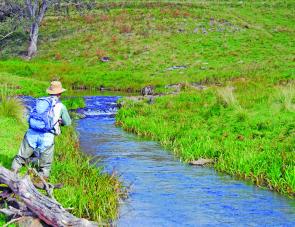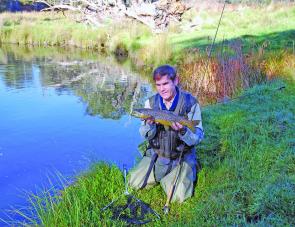The copious winter rain in New England might not have impressed the graziers too much, but keen trout fishers could hardly wish for a more favourable scenario.
Plenty of rain means plenty of tucker being washed in, getting the fish getting well and truly into feeding mode.
But keep in mind trout have very different feeding habits to you and I. They don’t need three meals a day and when food is scarce they just lay in their lairs and sit a spell. However when food is readily available they get stuck into it and tend to be always looking for more.
This is how we will most likely to find things come Saturday 2 October when the new trout season opens in New South Wales.
Remember you will need a license to fish for trout in NSW, which can be purchased online.
Ebor is located around two hours southwest of Grafton and east of Guyra. It’s the heart of New England’s trout fishing as it’s blessed with many idyllic streams, some of which are at very high altitudes too.
Most of the trout water between Ebor and Dorrigo is on private property but the landowners in the region are smart enough to realise just how much money comes into the district through angling. While owners will not usually refuse fishing access, it is expected that you request permission to access these waters at the nearest house.
My idea of light fly gear for Ebor is a five weight outfit with a floating fly line on the reel, 3m tapered leader with a 2kg breaking strain tippet to connect to the chosen fly.
Fly rods these days vary from premium to budget gear. I’ll let you in on a little secret: all rods will take trout, it’s just that the premium gear makes it that much more pleasant at the time. At any rate the fly rod you are quite comfortable with is the best one to use.
A pair of thigh waders makes for a successful trip, as they will keep the cold water, mud, and leeches off your trousers. A landing net is also handy to have to avoid dragging fish up onto the grass for release. Trout are often difficult to handle stream side as they are ultra slippery and tend to jump, kick and flip.
You should also include a jacket or light coat in your backpack, should the weather turn cold (which is quite possible at 1500m altitude,) plus a bit of light tucker for the time on the water.
Don’t forget a hat and sunglasses; I think the latter is mandatory for all flyfishing, as a mate once copped a trout fly his eye, which lead to a two hour drive to hospital for treatment.
Ebor is blessed with a huge number of stream insects. Amongst these are mayflies, so expect some worthwhile dun hatches towards evening with spent spinners hitting the water right on full dark.
Dry flyfishing is a big part fishing at Ebor and when duns are hatching an Adams dry in size 14 or 16 is hard to beat. That aside the Royal Wulff, also size 14 or 16, will certainly interest an Ebor rainbow when it’s rising. The clue is to cast the fly gently just upstream from the fish and watch for his reaction.
Another useful tactic for late afternoon fishing involves exchanging the dry fly for a size 16 black seal’s fur nymph; again fished on a totally greased leader, same as when dry fly fishing. Mucilin is the line grease of choice for mine.
The nymph should sit right in the surface film and as a fish takes it things will differ slightly from the dry fly take. With a dry fly the fish will show its head, but when nymphing the take is often just a movement of the leader accompanied by a swirl. But in either case as the leader moves so should the angler, lifting the rod or moving it to the side smartly – but not overly hard – to set the hook.
Other useful dry flies for Ebor streams are the Humpy, Greenwell’s Glory and Geehi Special. These flies can all be used when others have failed to produce fish. The Geehi Special is an old favourite of mine from Snowy Mountain days.
Stick with size 14 as the slightly larger fly will be easier for both the angler and quarry to see.
If the day is cold and windy with not much hope of surface activity there’s nothing wrong with a switch to a wet fly such as a Woolly Bugger, Red and Black Matuka or even a big (size 10) nymph on the leader.
Simply making sure all grease is off the leader by rubbing it down with a little streamside mud, will see the fly getting down far enough from the surface to interest a fish. The clue is to cast upstream and work the fly back in little twitches and jerks. Remember, don’t strike too hard or that 2.5kg tippet will pop. Trout can be surprisingly savage in their take as they turn and grab the fly.
Also keep in mind, there are a few brown trout in Ebor waters these days and these fellows are quite wary so softly, softly, is the way to go. Don’t rush up on a moving fish, keep back a bit and gently cast out your line.
There is ample water at Ebor for all, so just take things very slowly and enjoy the unique experience of fishing for trout around six hours drive from Brisbane. And don’t forget the warm gear: frosts are common in October in this area.
Reads: 10264
Small water can often produce surprisingly large fish; this Ebor stream contains fish over 1kg.

Mr Kampe with a fat Ebor brown trout – quite a few Ebor streams harbor these fish today.

Scott Kampe playing a trout in an Ebor stream.




